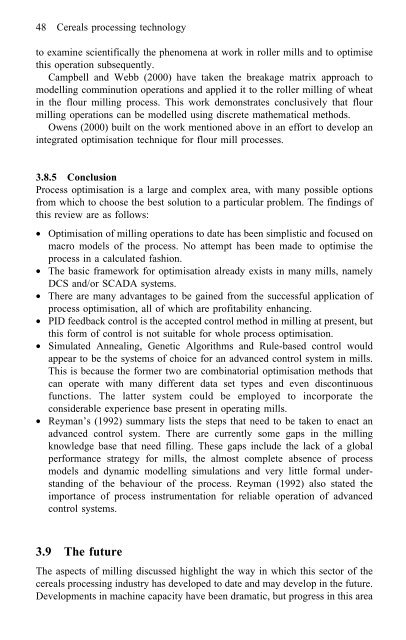Cereals processing technology
Cereals processing technology
Cereals processing technology
You also want an ePaper? Increase the reach of your titles
YUMPU automatically turns print PDFs into web optimized ePapers that Google loves.
48 <strong>Cereals</strong> <strong>processing</strong> <strong>technology</strong><br />
to examine scientifically the phenomena at work in roller mills and to optimise<br />
this operation subsequently.<br />
Campbell and Webb (2000) have taken the breakage matrix approach to<br />
modelling comminution operations and applied it to the roller milling of wheat<br />
in the flour milling process. This work demonstrates conclusively that flour<br />
milling operations can be modelled using discrete mathematical methods.<br />
Owens (2000) built on the work mentioned above in an effort to develop an<br />
integrated optimisation technique for flour mill processes.<br />
3.8.5 Conclusion<br />
Process optimisation is a large and complex area, with many possible options<br />
from which to choose the best solution to a particular problem. The findings of<br />
this review are as follows:<br />
• Optimisation of milling operations to date has been simplistic and focused on<br />
macro models of the process. No attempt has been made to optimise the<br />
process in a calculated fashion.<br />
• The basic framework for optimisation already exists in many mills, namely<br />
DCS and/or SCADA systems.<br />
• There are many advantages to be gained from the successful application of<br />
process optimisation, all of which are profitability enhancing.<br />
• PID feedback control is the accepted control method in milling at present, but<br />
this form of control is not suitable for whole process optimisation.<br />
• Simulated Annealing, Genetic Algorithms and Rule-based control would<br />
appear to be the systems of choice for an advanced control system in mills.<br />
This is because the former two are combinatorial optimisation methods that<br />
can operate with many different data set types and even discontinuous<br />
functions. The latter system could be employed to incorporate the<br />
considerable experience base present in operating mills.<br />
• Reyman’s (1992) summary lists the steps that need to be taken to enact an<br />
advanced control system. There are currently some gaps in the milling<br />
knowledge base that need filling. These gaps include the lack of a global<br />
performance strategy for mills, the almost complete absence of process<br />
models and dynamic modelling simulations and very little formal understanding<br />
of the behaviour of the process. Reyman (1992) also stated the<br />
importance of process instrumentation for reliable operation of advanced<br />
control systems.<br />
3.9 The future<br />
The aspects of milling discussed highlight the way in which this sector of the<br />
cereals <strong>processing</strong> industry has developed to date and may develop in the future.<br />
Developments in machine capacity have been dramatic, but progress in this area



